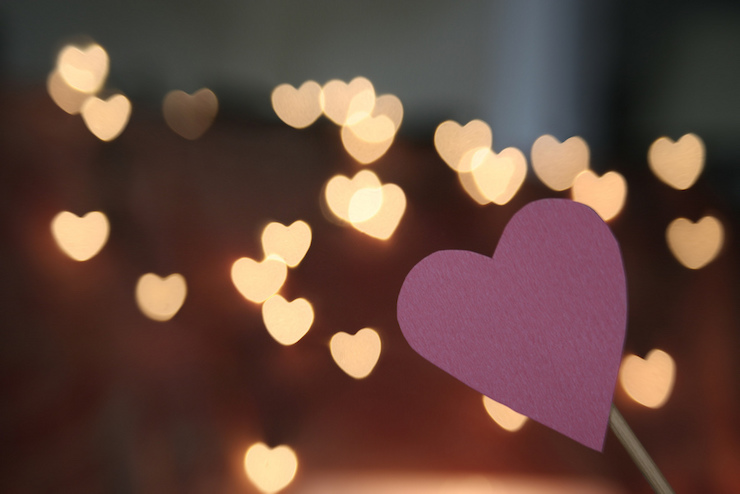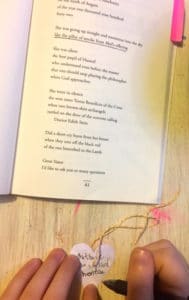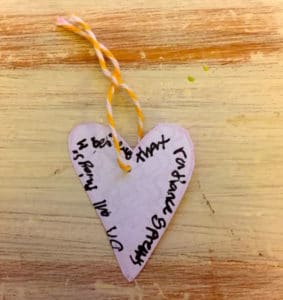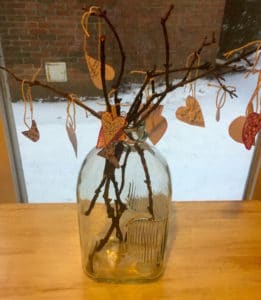
I bought milk in a glass jug—a charming, thick jug with no label except for the cap. The jug brought a comforting heftiness I felt when carrying it back to the fridge, a friendly clink and rattle when I twirled the cap back on.
“We should keep this jug after the milk’s gone,” my daughter Hadley said, scooping up the last of her Rice Chex, then lifting the bowl with both hands to slurp the rest of the milk.
I agreed. We needed to keep this jug.
“But what will we do with it?” my other daughter Harper asked. I told her I wasn’t sure, but something this delightful couldn’t be recycled just yet.
It was December when I rinsed the jug and placed it in the dishwasher; once it was clean and dry I placed it on a bookshelf, waiting for what would happen next.
The beginning of a new year is supposed to be an inspiring time for resolutions, goals, and intentions. But, to be frank, the newness I feel at this juncture is more stark, raw, like a tree branch that’s lost all its leaves. I don’t mind this feeling. I believe rebirth and growth will happen, but I’d like to spend a bit of time in the bareness of a new year.
So one afternoon, I took a walk around our backyard looking for sticks without leaves. I decided to fill the jug with fallen branches—a reminder that it’s okay to sit in the empty newness, enjoy its crispness, its vacancy, its silence.
The jug sat on our kitchen table holding the branches. The table is old and small, one my husband Jesse and I got 18 years ago. We’ve had Thanksgiving dinners on this table and lazy Sunday morning breakfasts. I wrote my first published essay on this table. It’s dented with marks from my pen, our daughters’ first attempts at scratching out letters on paper, accidental scrapes from a knife or fork.
One Friday long ago, Jesse had come home from work with a hankering to try a DIY project. “I’ll weather our table,” he said. He turned it on its side and rolled it to our balcony of the third floor condominium we were living in. All weekend he worked, sanding it and painting it white then sanding it again. It was a beautiful table before, but I love it more now because of what he turned it into. We can see the dents more clearly now, and there is fluorescent pink paint that won’t come off from an art project one of our daughters pursued on a rainy day. I am thankful for what this table shows, what it has held, and what it’s turned into.
Now the milk jug was holding bare branches at the edge of the table next to a window.
Making the Poetry Hearts

1 • Choosing a line to copy
The last week of January had me thinking about making paper hearts and hanging them on the branches. The girls and I drew hearts with pink markers on computer paper. Harper’s art teacher taught her how to Zentangle, a phrase I think is fun just to say, but it’s equally fun to practice.
Harper showed Hadley and me how to fill up a space with a design, and as we worked, we did some talking. We discussed recess and soccer, art, and books, boys and friends, Maryland and Michigan, all while we tangled designs into our hearts. We slipped string through a punched hole, tied a knot, and hung about ten hearts from the bare branches.
The next morning, I pulled a stack of books from our shelves and told the girls I thought it would be fun to write phrases we liked on the back of the hearts. I showed them my Anna Kamienska poetry book, Astonishments, running my finger under lines I liked.
Hadley liked “Gratitude is a scattered/homeless love,” and wrote that on a heart. I think scattered is the sound the dead leaves make when the winter wind blows, freezing the leaves back into the earth, sinking them into something new.

2 • Write It on Your Heart
Harper liked “I believe that radiance/spreads splendidly/on all things,” and wrote the words around the perimeter of her heart.
I said that the word radiance makes me feel warm as I spread cream cheese in thick swaths over our bagels.
“Mommy! Look out the window!” Harper stood, holding her Bear with one arm and pointing with the other. Hadley and I looked, and right away we knew what she was excited about—it was well before 8 a.m., and the sky was a fiery orange blasting away the dark and leading the sky to blue.

3 • Hearts Filled and Arranged
“Morning’s here,” Harper whispered. “Take a picture.”
I did, and the three of us returned to our kitchen table with the glass milk jug and winter branches. We ate our breakfast while we filled up our hearts.
Photo by jessicahtam, via Flickr. Post and inside photos by Callie R. Feyen.
__________________________

“This will be the main textbook for the poetry unit from now on.”
—Tom Hunley
- Poetry Prompt: Courage to Follow - July 24, 2023
- Poetry Prompt: Being a Pilgrim and a Martha Stewart Homemaker - July 10, 2023
- Poetry Prompt: Monarch Butterfly’s Wildflower - June 19, 2023
SimplyDarlene says
My favorite phrase of this piece are six words that read as poetry: “we tangled designs into our hearts.”
(BTW, I’m a jug-n-jar junky… squatty pickle jars, slender necked wine carafes, miniature miso paste jars, apple cider jugs with handles, on and on they fill my cupboards.)
Callie says
Thank you, SimplyDarlene. I like that line as well. Often, the design that’s in my heart feels tangled, you know? It felt nice to find a way to articulate that.
I’m glad to know someone else likes the “jug-n-jars” 🙂 I just filled another one this morning with flowers from Trader Joe’s. 🙂
Bethany Rohde says
What a lovely way to reuse that jug, and the beautiful experience with your children—in writing something we can all share in.
And what fabulous descriptions, I can hear the glass bottle now: “a friendly clink and rattle when I twirled the cap back on.”
Callie says
Thank you, Bethany! I had fun trying to describe why I love this milk jug so much. 🙂
Donna Falcone says
What a wonderful visit you have allowed all of us! I loved the whole piece, and the poem hearts a treasure! My favorite part of the whole experience was this:
“Morning’s here,” Harper whispered. “Take a picture.”
So beautiful.
Callie says
Donna, thank you so much. My little Harper says the most beautiful things. I want to capture all of it. I’m so glad you liked this, and thank YOU for stopping by to visit! 🙂
Sandra Heska King says
I loved this line: “it’s okay to sit in the empty newness, enjoy its crispness, its vacancy, its silence.” We’ve recently moved, and it reminds me there’s no hurry “find my place” here yet. I can just enjoy it. I’m writing this story on my heart. Thanks, Callie.
Oh, and now I’m heading over to check out that book. I’m all into astonishments.
Callie says
Sandra, have you recently moved, too? So have we. I think that’s why I’m sensitive to the New Year Resolutions, goals, and intentions this year. I think I want to be ok enjoying a place without knowing what my role is in that space. So, I can enjoy a bare stick and an empty milk jug just because. 🙂
I hope you enjoy Astonishments. That is one of my favorite poetry books.
Diana Trautwein says
This is lovely. Thank you.
Callie Feyen says
I’m glad you liked it, Diana. Thank you for letting me know!